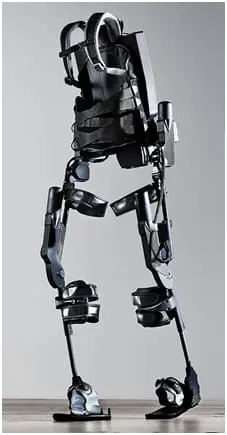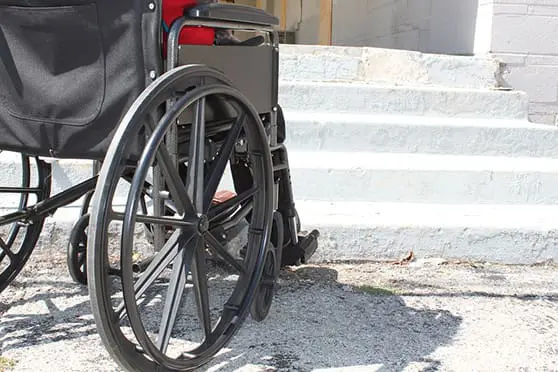Disabled Architect Illustrates Disability Risks
In December 2007, the sky seemingly fell on 39‑year‑old architect Robert Woo near ground zero while he sat in his trailer office working as associate architect on the Goldman Sachs office tower project.
Text
In December 2007, the sky seemingly fell on 39-year-old architect Robert Woo near ground zero while he sat in his trailer office working as associate architect on the Goldman Sachs office tower project. A crane cable snapped, dropping 7 tons of steel from a 25-floor elevation onto Woo’s trailer. Lucky to be alive at all, Woo was in stable condition by that evening, but the next day the father of three young boys learned he was paralyzed from the waist down and would never walk again.
 Confined to a wheelchair, Woo was unable to pick up his young children, and could not fully resume his career as an architect. Finally, after an extended period of rehabilitation that took its toll on his family, Woo was able to work occasionally as a consultant. Following a series of legal battles seeking compensation for his life crushing injuries, Woo found new hope in November 2011 when he traded in his wheelchair for a chance to walk again using Ekso Bionics exoskeletal legs. Exhilarated by the feeling of his first few steps upright and the dignity of being able to face his peers eye-to-eye again, Woo reflected, “We all need to enjoy life…you don’t know what’s going to happen the next day.” Woo’s optimism was hailed in the media as in line with his commitment to the quality and pursuit of his craft, and his desire to be strong for his family. (Sources: The Real Deal; and Gothamist ).
Confined to a wheelchair, Woo was unable to pick up his young children, and could not fully resume his career as an architect. Finally, after an extended period of rehabilitation that took its toll on his family, Woo was able to work occasionally as a consultant. Following a series of legal battles seeking compensation for his life crushing injuries, Woo found new hope in November 2011 when he traded in his wheelchair for a chance to walk again using Ekso Bionics exoskeletal legs. Exhilarated by the feeling of his first few steps upright and the dignity of being able to face his peers eye-to-eye again, Woo reflected, “We all need to enjoy life…you don’t know what’s going to happen the next day.” Woo’s optimism was hailed in the media as in line with his commitment to the quality and pursuit of his craft, and his desire to be strong for his family. (Sources: The Real Deal; and Gothamist ).
Often, random misfortunes are viewed with an “it won’t happen to me” mindset, but statistically, conditions contributing to prolonged disability are more commonplace than one may think. For example, pedestrian accidents are a far greater disability risk than 7-tons of steel falling from the sky. More alarming than both of these is the spike in disability claims due to illnesses that are on the rise among baby boomers, such as mental illness, Parkinson’s, MS, stroke, Alzheimer’s, and type-2 diabetes—at levels astonishingly higher than their parents’ generation (Sources: Huffington Post; and New York Daily News).
 Architect Eliel Saarinen once said “Always design a thing by considering its next larger context—a chair in a room, a room in a house, a house in an environment, an environment in a city plan.” These days, such an approach should be considered in life, such as—“Always design a life by considering its next larger context.” Just as blueprints map out every eventuality, a sound income replacement plan provides for an alternative to Social Security Disability Income (SSDI) whose roof is forecasted to cave in before decade’s end.
Architect Eliel Saarinen once said “Always design a thing by considering its next larger context—a chair in a room, a room in a house, a house in an environment, an environment in a city plan.” These days, such an approach should be considered in life, such as—“Always design a life by considering its next larger context.” Just as blueprints map out every eventuality, a sound income replacement plan provides for an alternative to Social Security Disability Income (SSDI) whose roof is forecasted to cave in before decade’s end.
Workers within 10–14 years of retirement age are applying in greater numbers than ever before, with little hope of returning to work at all. States like California and Florida have cumbersome application backlogs exceeding 56,000 with year-long waiting periods. Statistics like this indicate that in order to remain viable beyond 2016, the program will require much more than a retrofit. Fortunately for AIA members, the AIA Trust provides them with the tools to construct a life on durable foundations by purchasing Group Long-Term Disability Insurance as a pillar of their income stability.
While the chances of suffering a serious tragedy like that of Woo are slim, the likelihood of needing disability insurance is real: statistics show that one in four architects will potentially suffer from a health incident that puts them out of work. Which of these designs would you approve?
#1 John Smith, a 52-year-old architect living in Florida earning $105,000 a year, is diagnosed with Parkinson’s disease and becomes incapable of ever returning to work. Smith’s only financial safety net is to rely on SSDI once his private short-term disability coverage runs out. After burning through retirement savings waiting for SSDI to kick in, he begins receiving a disability benefit of $2000. His wife finds part-time work paying $1500/month, but they still have to draw from savings and cut the household budget by 60% to keep up with their mortgage.
#2 John Smith, a 52-year-old AIA member architect living in Florida earning $105,000 a year was well trained in the utility of employing equilibrium to create enduring structural integrity, so he took advantage of the affordable group long-term disability insurance offered to AIA members. He knew that this coverage included an important feature that protected him if he was unable to return to work specifically as an architect, not just any occupation or career. And, this coverage provided a benefit of up to 60% of his gross earnings at the time of disability, adjusted based on any SSDI benefit he may receive, for a total maximum benefit level of $6,000.00 a month.
Galileo once wrote, “Measure what is measurable, and make measurable what is not so.” In the second story, Smith anticipated unseen risks and accounted for them in his big picture financial plan. Equipped with access to essential financial security products such as the AIA Trust Group Long-Term Disability plans, AIA members have all the tools they need to blend art with life and design their own income security Golden Ratio.
To learn more about disability coverage and all AIA Trust programs, click here.
More on Life & Health & Retirement & Financial Planning

Straightforward Advice on Preserving Cash Flow
Professional Liability ▪ Retirement & Financial Planning ▪ Article
Top 10 List of Long‑Term Care Policy Considerations
Retirement & Financial Planning ▪ Article
Employee Benefits Help Maintain Firm Success
Firm Management ▪ Life & Health ▪ Small Firms ▪ Article ▪ Newsletter